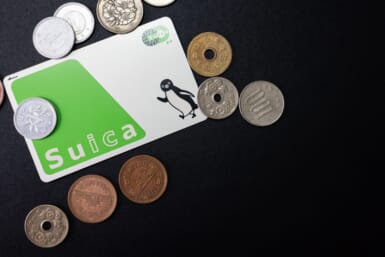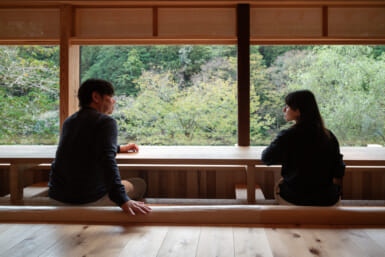Every now and again someone does something—someone makes a good move—and you’ve just got to say that ain’t ‘arf bad…
That’s the way I felt when I got the news the other day of the appointment of the first director of the new Mori Art Museum of the Mori Arts Center. His name is David Elliott. He takes up the post in the autumn of this year.
Mr. Elliott will be based in Tokyo. His office, I am informed, will be in the Nissan Building near Roppongi—the one on the left, as you go towards Shibuya, about 200 yards from the crossing.
From there, the new appointee—the first foreigner to head up a major fine arts museum or the like in this country’s history—will be close to the scene of the action, that whopping Roppongi 6-chome building site, with all those cranes sticking up. That is where Mori Building (no less) is putting up an array of new buildings, the tallest of which is to be topped, as to the uppermost floors, with an Arts Center the likes of which the world has yet to see.
They say, also, that the Roppongi 6-chome scheme is the largest urban redevelopment project ever in Japan. Some compared it with mid-town Manhattan’s Rocky Center—otherwise known as the Rockefeller Center. It is a project that will, with luck, focus the energies and hopes of an entire nation. Meanwhile the crowning feature of the ensemble—the counterpart perhaps to Radio City Music Hall in the original Rocky Center layout—is the Aits Center in the sky. Those who have been planning this thing, for years now, aim to attract millions of visitors a year, so the first and most obvious thing is that the lifts—excuse me, the elevators—have got to work.
Given all of the above—the intended international prominence of the new center; compare it with the Tate Modern in Britain today, a new institution that has just pulled in more than 5,000,000 visitors in its first full year—you’d have been fairly sure that a Japanese would have been chosen as chief panjandrum. But not so; the powers that be settled on a fellow Brit. I am told that David Elliott is currently the director of a modern art museum in Stockholm. He is one of a small band of international art professionals who base themselves in Europe and/or America—and now in Japan…
How did this happen?
Japan has many things going for it, but it is not known as the home of a flourishing community of curators of modern art. There are some otherwise excellent individuals, but no one of whom you would say that he or she really knows his stuff. It’s a plain fact.
So the obvious thing to do was to reach out of Japan and find the best person available for the job outside. The most flourishing modern art establishment in the world today is the Tate in London. But people turned to New York— and to Glenn Lowry, the director of the Museum of Modern Art (MOMA) for advice, mainly.
MOMA has had an upper hand in advising on the development of the Mori Arts Center for the last couple of years, so it is not surprising that the choice settled on someone who came with Dowry’s blessing. Mr. Elliott can be counted on to put on exhibitions in Tokyo that tap into the flow of possibilities available in the world at a given time—this is something that probably no home-grown Japanese director could have done—and draw visitors by the millions.
The next question is: will it work? I don’t see why not, but let me try to justify my usual optimism. As I never tire of writing here, Japan is changing at the speed of light. The Tokyo of two years ago simply does not exist here any more.
Consider, for example, the way people do business. Just consider office routines. Up to a few years ago hardly anyone had a Website or an e-mail address! It makes you practically fall off your chair to look back just a couple of years.
The same applies—switching to the cosmic in art—in the world of modern art institutions. Up to a few years ago, no one—with the possible exception of one or two folk at the Tate—had imagined that you could take a disused power station on the south bank of the Thames and turn it into the most discussed art institution in the world today (the Tate Modern). To shift that magic to Tokyo is not beyond the wit of the individuals involved, by any shadow of means.
The interesting thing is that the appointment of the new director of the Mori Art Museum caught the masukomi here—the newspapers, for example the Nikkei, normally a fount of wisdom on the arts— completely off-balance. They just were not prepared for it. The fact that this illustrates is that the big daily newspapers here are about as Old Economy as you can go in Japan today. They failed to take much note of the most exciting new appointment in the modern art world in Japan in a very long time. The matter was barely recorded.
Thus—and here’s my concluding point—the invitation to David Elliott was issued by Minoru Mori, the president of Mori Building, against a background of almost complete press indifference, as I registered it.
It will be good to see the press here catching up with what has happened in the years to come. The Mori Arts Center is not due to open for a couple of years. Everything awaits the decisions of the newly appointed director.
More power, I say; let ’em roll.
Mr. Mori himself is cock-a-hoop, as you can imagine. He believes that he has pulled off a coup by appointing an outsider to whom he can refer all major decisions regarding the functioning of the new Center.
“Five million visitors at the Tate Modern in the first year,” he says, musing, “That’s a lot of people.”
He clearly hopes to do something on the same scale.
I ask myself if this is going to work. Will Mori-san permit the new director to have autonomy? I am sure that he will. There is no other way to do it. The really key decisions then have been (a) to appoint someone from outside Japan, and (b) to guarantee powers of decision to that new person. Otherwise, the whole strategy would make no sense whatever.
David-san, good luck.









